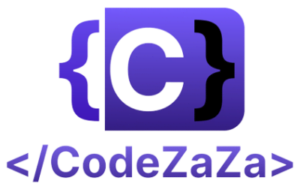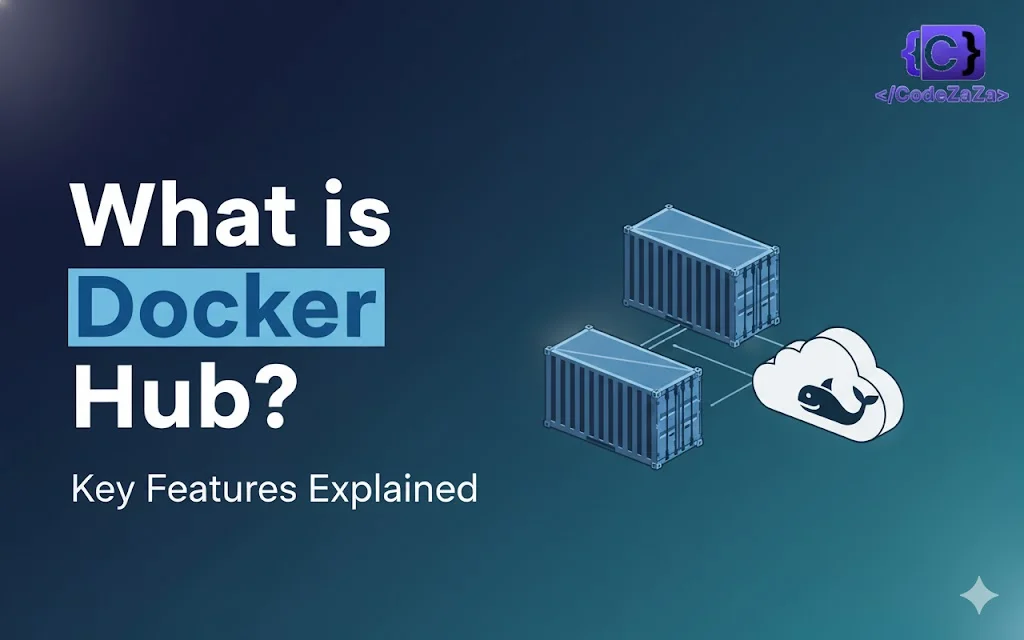Docker Hub is a cloud-based repository service that helps users store, share, and manage Docker container images. Docker offers this service as part of its platform. Developers use Docker to package their applications and dependencies into lightweight, portable containers. These containers run consistently across different environments, which makes deploying and scaling applications much easier.
Docker Hub serves as a central hub where Docker users can discover, share, and collaborate on containerized applications. It hosts an extensive library of pre-built Docker images that include databases, web servers, programming languages, and many other tools and services.
Users can easily search for images by functionality, operating system version, or keywords and pull them into their local environment with a single command.

Features and Benefits of Docker Hub
Docker Hub is a cloud-based repository service offered by Docker that provides numerous features designed to simplify the creation, deployment, and management of containerized applications. As the global hub for Docker users, it enhances productivity, ensures security, and streamlines collaboration across the container lifecycle.
Centralized Repository
Docker Hub allows you to search, access, and share containerized apps and services. By serving as a single source of truth, the central repository simplifies the management of Docker container images.
Vast Library of Images
It provides access to a huge library of pre-built Docker images, including popular web servers, databases, programming languages, and frameworks. Instead of starting from scratch, developers can quickly find and select images that match their unique requirements, which significantly speeds up development.
Open Collaboration
Docker Hub encourages open collaboration among developers. You can share your own Docker images with the community, build upon others’ work, and improve existing images. This knowledge-sharing environment accelerates development cycles and fosters innovation.
Automation Tools
It offers tools to automate the build, test, and deployment of Docker images. For example, Docker Hub integrates with CI/CD pipelines to enable smooth continuous integration and delivery workflows. Automated builds also start whenever changes are pushed to a repository, reducing manual effort and errors.
Versioning and Tagging
Docker Hub supports versioning and tagging of Docker images, making it easier to manage and track multiple iterations of an application. You can roll back to previous versions when needed, ensuring consistency and reproducibility across different environments.
Access Control and Permissions
Docker Hub provides powerful access control and permission features. Teams can regulate who can view, edit, and share Docker images, which is essential for maintaining the security and integrity of confidential or proprietary applications.
Scalability and Performance
As a cloud-based service, Docker Hub delivers high-performance infrastructure and scalability for hosting and distributing Docker images. This ensures reliable and fast access to images, regardless of repository size or popularity.
Integration with Docker Ecosystem
Finally, Docker Hub integrates seamlessly with the larger Docker ecosystem, including Docker Engine, Docker Compose, and Docker Swarm. This unified platform supports the entire lifecycle of containerized applications, from development to production.
How to Create a Docker Hub Repository?
Its quite easy and simple to create a Docker Hub repository. Here’s a basic guide −
Step 1: Sign in to Docker Hub
Visit https://hub.docker.com/ to create a Docker Hub account and sign in using your credentials.

Step 2: Create a New Repository
After you have completed the signup process, you will be directed to your Docker Hub dashboard. You can manage your repositories, images, and account settings here.
To create a new repository, click on “Repositories” in the menu bar and then click on the “Create Repository” button in the upper right corner of the dashboard.

Step 3: Choose Repository Visibility and Details
Here, you can provide the repository name, details, and visibility of the repository. Public repositories are visible to everyone. On the other hand, private repositories restrict access to authorized users only.

Step 4: Save and Create the Repository
You can click the “Create” or “Save” button to create your repository. Once the repository is created, you can access it from your Docker Hub dashboard. You can configure the builds, webhooks, tags, and other setting here.
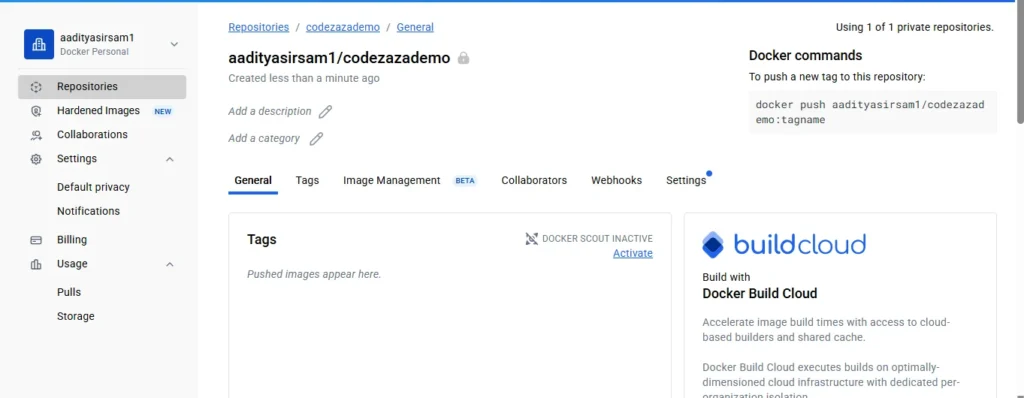
How to Push or Pull Images from Docker Hub?
You can use the Docker commands to push and pull Docker images to and from a Docker Hub repository. Here’s how you can do it −
Pushing Images to Docker Hub
In this section, let’s see how you can push images to Docker Hub −
Step 1: Tag Your Image
Before you push an image to Docker Hub, you should ensure that it is properly tagged with the repository name and version.
Here, we will use a “hello-world” image from the Docker Hub public repository for reference. You can tag an image using the following command −
$ docker pull hello-world $ docker images $ docker tag <image_id><username/repository_name:tag>
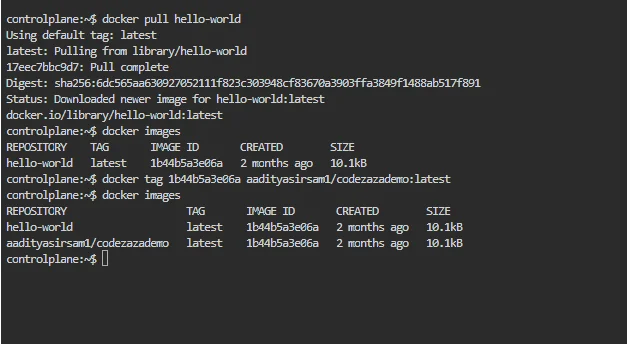
Step 2: Log in to Docker Hub
Before you can pull or push images from your private repository, you have to log in to Docker Hub using the command line. You can use the docker login command to authenticate with Docker Hub using your Docker Hub username and password.
$ docker login -u Username
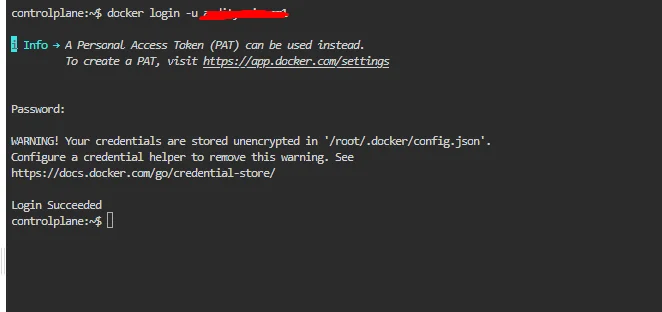
Step 3: Push the Image
Now that you have logged in, you can use the docker push command to push the tagged image to Docker Hub.
$ docker push <username/repository_name:tag>

You can verify the pushed image in the Docker Hub repositories.
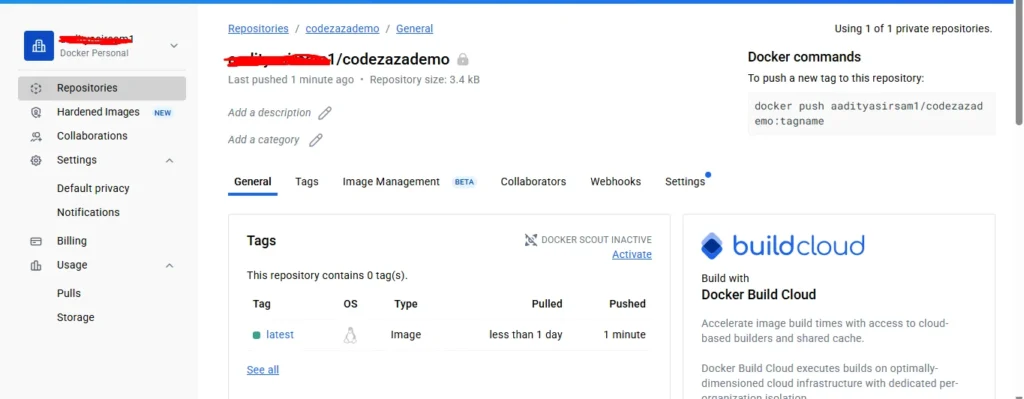
Pulling Images from Docker Hub
You can use the Docker pull command to pull the images from Docker Hub.
$ docker pull <username/repository_name:tag> $ docker images
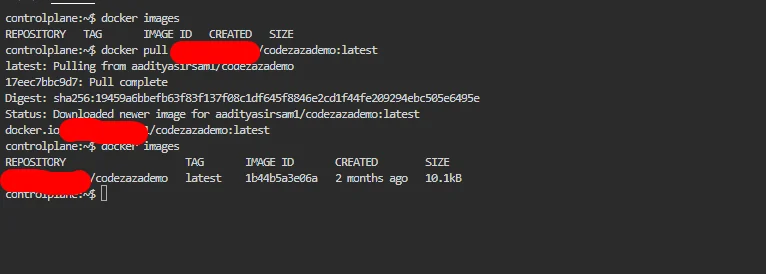
Key Components of Docker Hub
Docker Hub is a comprehensive platform with several key components that enhance the automation, security, and management of Docker images. To understand how it works, let’s explore its crucial elements.
Repositories
Repositories serve as the storage units for Docker images. In particular, users can store, manage, and share their images within these organizational units. Public repositories are accessible to everyone, whereas private repositories are restricted to authorized users.
Webhooks
Webhooks enable automated responses to events that occur within repositories. For example, users can set them up to trigger actions such as initiating builds, sending notifications, or executing other processes whenever images are pushed or updated.
Service Accounts
Service accounts authenticate and grant access to Docker Hub services and APIs. As a result, automated processes, such as CI/CD pipelines or external tools, can securely communicate with Docker Hub without human intervention.
Vulnerability Scanning
Docker Hub offers vulnerability scanning to detect security flaws in Docker images. Consequently, this feature helps users identify and mitigate potential risks by scanning images for known vulnerabilities in their dependencies and providing actionable insights.
Mirroring
Organizations can mirror Docker Hub repositories to private infrastructure or internal registries. By doing so, they reduce latency, ensure reliable image access, and give administrators control over how images are distributed within their network.
Automated Builds
Automated builds streamline the creation of Docker images by automatically starting builds whenever changes are pushed to a linked repository. Therefore, this eliminates manual intervention and ensures images are continuously updated with the latest modifications.
User Interface (UI) and API
Docker Hub provides an intuitive web interface for interacting with repositories, managing images, and performing administrative tasks. Moreover, it offers a robust API for programmatic access, making integration with external tools and automation workflows seamless.
Benefits of Docker Hub
- Centralized Repository
Docker Hub provides a single, centralized location to store, manage, and share Docker images. This simplifies collaboration and ensures that teams always use the correct versions of images. - Extensive Library of Images
It offers access to a vast collection of pre-built images, including web servers, databases, programming languages, and frameworks. Developers can save time by reusing images instead of building from scratch. - Open Collaboration
Docker Hub fosters collaboration by allowing developers to share their own images with the community. Teams can build upon existing images, share best practices, and speed up development cycles. - Automation Tools
Docker Hub integrates with CI/CD pipelines and supports automated builds, enabling developers to automatically build, test, and deploy images when changes are pushed to repositories. - Versioning and Tagging
Docker Hub supports image versioning and tagging, making it easy to track changes, roll back to previous versions, and maintain consistency across different environments. - Access Control and Security
Users can manage who can view, edit, or share images. Private repositories and granular permissions ensure sensitive projects remain secure. - High Performance and Scalability
As a cloud-based platform, Docker Hub provides reliable infrastructure with fast access to images, regardless of repository size or global demand. - Seamless Docker Ecosystem Integration
Docker Hub integrates smoothly with Docker Engine, Docker Compose, and Docker Swarm, providing a unified platform for developing, deploying, and managing containerized applications.
Real-World Use Cases of Docker Hub
- Centralized Repository for Enterprise Teams
Large organizations use Docker Hub as a single source of truth for storing and sharing images across multiple development teams. For example, a fintech company maintains all its microservices images in Docker Hub so developers in different offices can access consistent versions. - Rapid Development with Pre-Built Images
Startups and independent developers pull pre-built images for databases, web servers, or programming languages to quickly prototype applications. For instance, a SaaS startup might pull an official MySQL image to set up a test environment in minutes. - Open Collaboration in Open-Source Projects
Open-source projects use Docker Hub to share images with contributors worldwide. Projects like WordPress and Node.js maintain official images, allowing developers to build upon them and contribute improvements. - Automated CI/CD Pipelines
Tech companies integrate Docker Hub with CI/CD tools like Jenkins or GitHub Actions. Whenever developers push code, Docker Hub automatically builds the updated image, which can then be deployed to staging or production environments, reducing manual errors. - Versioning and Rollback in Production
E-commerce platforms use Docker Hub’s versioning to safely deploy updates. If a new feature introduces bugs, teams can roll back to a previous stable image without downtime. - Secure Access for Sensitive Projects
Healthcare or financial institutions rely on Docker Hub’s private repositories and granular access controls to protect proprietary applications and sensitive data while allowing authorized teams to collaborate. - Scalable Image Distribution Globally
Cloud service providers and multinational companies host Docker images on Docker Hub to ensure fast, reliable access worldwide, regardless of repository size or traffic spikes. - Seamless Integration with Docker Ecosystem
Companies building microservices architectures use Docker Hub alongside Docker Engine, Compose, and Swarm to manage, deploy, and scale containerized applications efficiently across development, testing, and production environments.
Conclusion
To sum up, Docker Hub is an essential resource for developers and enterprises seeking efficient ways to manage Docker container images. By providing a centralized repository, it simplifies the storage, sharing, and distribution of containerized applications and services.
The platform also includes features such as vulnerability scanning, webhook integration, and automated builds, which streamline development and deployment while ensuring security and compliance. Additionally, Docker Hub offers a robust API and an intuitive interface, making it easy to pull images for local development or push them to the repository for deployment.
Common Interview Questions
Q1. What are Docker registries?
Docker registries are storage units for Docker images. They act as places to store, manage, and access Docker images. They serve as centralized hubs for the distribution of containerized services and applications, enabling developers to distribute or share images among different environments. Organizations can create their private registries for internal use, although Docker Hub is one of the most widely used Docker registries.
Q2. Is Docker Hub free?
Docker Hub provides both premium and free plans. Users can store an infinite number of public images and create public repositories with the free plan. The quantity of image pulls and private repositories are restricted, though.
Docker Hub provides paid subscription plans with different pricing tiers for users who need extra features like more storage, private repositories, and improved security.
Q3. What are repositories in Docker Hub?
Repositories are organizational units in Docker Hub that are used to store Docker images. There may be several image versions in a repository, each identified by a unique version number.
Public repositories are open to the public, while private repositories are only accessible to authorized users. Repositories can be classified as either public or private. Depending on the requirements of their project or application, users can create, manage, and share repositories.
Q4. What are other alternatives to Docker Hub?
There are several Docker Hub alternatives available in the market. Users can store and manage Docker images directly within GitHub repositories using the GitHub Container Registry (GHCR). You can also use Amazon Elastic Container Registry (ECR), which is a fully managed Docker container registry service provided by AWS.
Google Cloud Platform (GCP) offers the Docker container registry service Google Container Registry (GCR). Harbor also acts as an open-source registry for containers, providing sophisticated features like vulnerability scanning and role-based access control.
